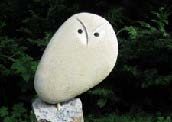
Home » Journal Articles » Thoughts & Opinions » I Wish I Had Done That
George Pratt Pats Michael Binkley On The Back . . .
There have been many sculptures produced by my friends/colleagues in NWSSA whence I could happily apply the title line, but my current envy trip is this remarkable piece of Michael’s. He aptly has entitled it ‘Making Space’. I’ve visited it twice now in his studio and both times came away obsessed with its excellence. It truly captivates me. Here’s why:
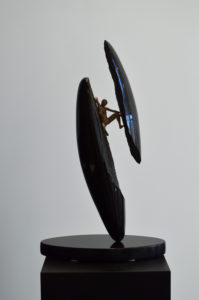
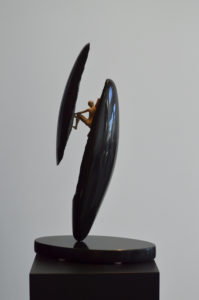
– He did not choose a tried and true, tailored stone for the work i.e., like a piece of dimension marble. Encountering a broken black funerary monument, he exploited what otherwise would have been destined for the scrap heap; a textbook study around the word ‘inspiration’.
– The perfectly paired and polished surfaces, the absolute invisibility of the mounting, the general execution of the whole work, merit profound admiration to be sure. But what really grabs me here is the totality of sculptural experience required to get this work ‘right’. I’m thinking Michael probably started out just cleaning up the two broken halves with no greater purpose for them in mind. The first thing he did was achieve perfection in the polish (hey, it’s black granite! Try it!) which could only have been done by summoning up the skill of long experience.
Along the way, he had to be puzzling out some way to present the two halves being held apart; it would make a very weak story to simply clap them together again after polishing. Various methods come to mind – pinning in some way being foremost, or possibly using adhesives. The notion of presenting them as boulders with a human character holding them apart was a eureka moment in creativity. I don’t know that I’d have ever thought of it.
But how to make such a human character? It could perhaps be done in some kind of stone, maybe marble — but what Michael did do was illustrative of a restless creativity that had him eternally reaching out to expand his ability in sculptural arts. A curious mind had him playing with computer software that allowed him to execute 3-D imaging; in an apocalyptic moment he conceived of, and created, a human figure to do the pushing. It is metal sculpture, not stone sculpture, but it is no less of an adulteration than metal pins doing the job.
Michael finessed it all by correctly calculating the size the human must be relative to the stone ‘boulders’ so that certain feelings are evoked. To me, the boulders represent a looming, insistent power, trying ever to close — but here is a valiant savior struggling against overwhelming odds to fend off certain disaster. My mind runs to the little Dutch boy holding his finger in the dyke.
For me, the sculpture evokes TENSION. I feel it. All the time I’m looking at the sculpture I can’t stop feeling it.
Would I have done anything differently? Well, I write about this fine piece of Michael’s because I doubt I would ever have conceived of it at all. The important thing I have to say is ‘Good on you, Michael! Wish I had done it . . . !’


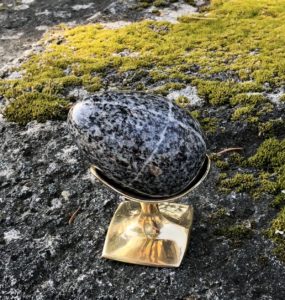
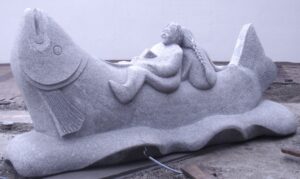


We need some kind of descriptive text here.